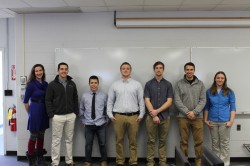2015 TEAM 6
Team 6
Our central goal behind this project is to design and manufacture a working recorder instrument to accommodate a child with normal right hand and limited left hand capabilities. This instrument will enable the child to reach a fifth grade level of music playing, which includes nine unique notes. The completion and success of this project is based on specific design criteria including overall safety, musical ability, ergonomics, and practicality for the individual child.
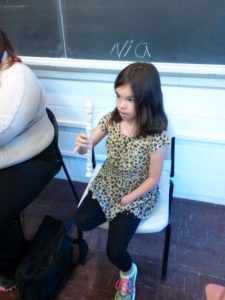
Week 26 04/27 – 05/01
On Wednesday 04/29, our campus’s “Maine Day” was the date of our final design competition where our client Nia and music teacher get to choose which team’s design will suit Nia’s requirements to play the recorder in the near future. Our team’s design did quite well in the events that were mentioned in last week’s update. Our final design proved to be satisfactory in all safety, ergonomics and overall practicality. The case race involved one team member being timed to open the case play a note on the recorder and put the recorder back in its case. Our team had the best time of just over 9 seconds. Our design being as simple as it is also awarded us one of the best in the cleaning category. With minimal parts and a simple design, the judges were impressed with how easy it was to clean our recorders design. In the end our recorder design was not picked by Nia or her music teacher due to one of our notes not reaching the right pitch tone. This high pitched note was made clear in both the music quality event and the “Camp-Town races” song demonstration. We believe it was due to the overall length of the recorder that affected the tone. The company that printed out the recorder had a limit to printed length which was just short of the actual recorder length. Had we had more time we would have liked to add a part that would extend the recorder and move the holes closer to fix this problem. Overall all the completion went well. Our team managed to score 51 points out of a possible 80 points giving us second place. The links below are of the video of the design competition day including channel 5 news.
The links below are of the video of the design competition day including channel 5 news.
http://youtu.be/_7H7fmF22OY
http://wabi.tv/2015/04/29/one-handed-8-year-old-plays-instrument-thanks-to-engineering-students/
Week 25 04/20 – 04/24
Next week is our design competition and display of our final project to our client Nia and her music teacher. This competition has been broken down into a series of events that each of the design teams will partake in throughout the morning. The events (shown below) will show every dynamic of our design from practicality to actual acoustical performance.
– Music Quality
o Safety
o Practicality
o Ergonomics
– Case Race
– Cleaning
– Presentation (8-10 Min)
– Camp-Town Races (Song Demonstration)
Photos of the competition day will be uploaded to the webpage’s photo gallery soon after the competition.
Week 24 04/13 – 04/17
The final recorder is still in the process of being manufactured and shipped from Belgium. The expected shipping is on April 28th, which leaves us only a day to make the finishing touches to the final product. We decided to have a second recorder printed out from the same place with priority shipping which will come in next week (04/21). This printed recorder is a rough print out to see the new changes that were made. This week while we waited for the recorders to come in, we were able to progress in the overall final package by completing a carrying case for the recorder. This carrying case has a zipper mechanism with a shoulder strap to help with opening the zipper and for ease of carrying around.
Week 23 04/06 – 04/10
During this week we were able to meet with our client Nia at her school. For this meeting we were able to determine exactly where to line up the holes/valves to ensure full comfort and practicality for her. Turns out that rotating the valves towards the bottom of the recorded rather than lined up on top works, is the best for Nia to play the desired notes. This overall placement of the notes also improves the moment of the recorder while its being played. The three places of contact that Nia will have on the recorder is improved with the valves moved towards the bottom creating equal and opposite forces. After making the changes to the design we sent out the design files to a company in Belgium to have a final working product to work with. Throughout the remaining weeks we will be applying the finishing touches to the recorder. These final touches include but not limited to the overall surface finish and color, valve padding, acoustic testing, and creating a final package with directions and spare parts for the client. Photos and drafts of the final prototype that were sent to Belgium can be found in the photo gallery at the bottom of our page.
Week 22 03/30 – 04/03
After our meetings with both our client Nia and P.E. Shawn in the past couple weeks, we were able to print out a new prototype with the improvements. After printing it out with its corresponding valves we noticed that the acoustics were improved but were still a bit off. We believe that the connection of the printed half to the original recorder half is effecting the overall sound. The two parts connect right up against the first valve. Photos of this design are in the photo gallery. We have decided to try printing the whole bottom part in one piece to avoid the effect on the sound. This design is shown in the photos below. One of the issues we had with the new print was the separation between the individual valves. The meeting with Nia reinforced this as it was putting a lot of stress on her wiggle reaching the notes. After modifying the valves we were able to put the valves within .050” from each other. By doing this the spring hole had to be offset to account for the shift.
While we work on this design we have also sent out our CAD files of our design out to a company in Belgium to be printed in one piece. This should fix our issue of getting the right sound and acoustics of the lower printed holes. More work will have to wait until we get the new prototype sent to us.
The photos that were taken during our meeting with Nia have been uploaded to the photo gallery at the bottom of our page as with the recorder prototypes.
Week 21 03/23 – 03/27
On Wednesday 03/25/15, we were able to meet with our P.E Shawn Eary to share and discuss our changes to our overall design that was mentioned in last week’s update. In the meeting we were able to get his opinion on the drastic changes that were made. By the end of the meeting we were able to come up with two possible design directions we can take. The first was to modify the valve attachment so that the valves were naturally open rather then closed. This method would have us not only switch the springs around but also have us consider looking into much lighter springs as the force requirement to keep valves open is much less then needing to keep them closed. This method would also help solve our current obstacle of sealing the recorder holes. The other possible design is to 3D print the bottom half of the recorder, where like the first design, the valves would be naturally open which is shown below. The idea behind this approach was to avoid having an attachment all together which could help with the sealing and mounting of other parts. The issue we are having with this approach when the recorder is 3D printed we are risking the effects that it will have on the overall recorders acoustics. The 3D MakerBot that prints out our prototypes limits us to printing the bottom recorder piece in two parts, as shown below. The connecting of the two parts we feel is tampering with the acoustics. Throughout the week we will be looking into both design paths and making a decision which one will be best for our client and the allowed time we have left.
MET Showcases Capstone at Engineering Expo in Gorham
Four teams represented MET at the Engineering Expo at the University of Southern Maine in Gorham. MET was one of among dozens of tables representing companies and schools throughout Maine.
The Expo Team described the Capstone project to hundreds of parents, children and professional representatives about Nia and her need, the use of 3D printing to produce useful objects and the program as a whole.
The Team also gave away hundreds of 3D printed Space Invaders from the classic arcade game, and custom designed fidget rings that can be assembled and reassembled in a variety of styles and colors.
Week 20 03/16 – 03/20
After our visit with Nia before our two week spring school break, we decided to make some drastic changes to our design. During our meeting we noticed Nia having some difficulty actuating all the valves at once and had no comfortable place to rest her pinky on the mount. The valve length and position will be looked into to ensure Nia will be able to close all three valves at once. We also looked into different spring options to decide whether or not torsion springs are better than helical springs. We also are looking into the orientation of the new hole design. The hole can be oriented on the top or bottom and even the sides of the recorder. New mock-ups will be worked on as with setting up more meetings with Nia in the near future to see how she likes the new design changes.
Week 19 02/23 – 02/27
Based on the progress made last week, we are making an effort to have a fully working model of our design this week. This working model will enable us to see where we are in the design process and what things we need to do to reach the requirements in our given time frame. Our goal is to have the entire project completed by April 29th, 2015, the day of our competition.
Throughout the week we have been able to make great progress with both our design and research. We have modified the mount and decided to try making the valves a bit wider. A more in-depth analysis will be done within the next few updates. We’ve also started researching ASTM standards for the testing that will be done within the next few weeks. These standards include durability and destructive/non-destructive testing for our mount. One ASTM standard that we found to be useful was the indoor lighting aging process on plastics. This standard showed us that the use of the U.V disinfecting case is no longer a possibility due to the deterioration it can cause to ABS plastics (ASTM D4329-13).
As mentioned in last week’s update, we were able to plan a meeting date with our Client Nia which will be on Thursday February 26th, 2015. See link below to view our Design Criteria
Design Criteria
Design Criteria
Week 18 02/16-02/20
At this point in our project we are more focused on the smaller aspects of the design and the testing that is entailed. Our overall design has shown enough reason to believe it can pass the required design requirements. Our meetings with professionals and various testing has proven that. We are now looking into the final details of the design that will make our project the best it can be. These final design challenges include the sealing shape and material of the recorders holes, the multifunctional pinky rest, and the valve mechanism for the note combinations. We decided to test the recommendations made by Glen Sargent and look into the use of various leather materials to seal the holes. Leather is a typical material that is used in instrument padding which was verified in our visit to Bangor Brass and Woodwind where we were able to talk with the owner, Joe Shaw. We were referred to the following materials: Music Grade Leather, Fish Membrane, Cork, and Neoprene. We’ve also made good progress on the pinky rest design, shown in the photo below. This pinky rest will fit on the back of the mount and will be concentric with the back of the recorder. The pinky rest is adjustable and acts as a locking mechanism that Nia can use so she won’t get tired. If you lift the first valve it also lifts the other three. This mechanism prevents the first valve from resealing the holes by sliding and locking into place on the mount. How we’re planning on mounting the pinky rest is still in progress. We are planning a visit with the client Nia, to finalize the details. Outside of the actual design of the mount, we’ve also started looking into ways to make the use of this recorder easier on Nia. We researched basic ways to make learning music easier, and color coding was a proven method. Knowing that, we color coded the music sheets that she will be required to know, with red, yellow, blue, and green, using Microsoft paint. We have also added a symbol for the locking lever mentioned before to hold open the device to play the G-note.
Week 17 02/09 – 02/13
As mentioned last week, we were able to be meet with Glen Sargent, a Professor who repairs instruments here at the University of Maine. This meeting was very beneficial as we were able to discuss all the aspects of our current design project. Having a career that involves a wide array of instrument design, repair, and construction, Glen was able to share very useful information that related to our current design. During the meeting we were able to go over our current design obstacles such as the sealing of the holes, specific note playing combinations, and even ways to properly disinfect the recorder. Overall the meeting was very successful as we were not only able to receive professional feedback on our current design, but also great ideas to think about moving forward.
Week 16 02/02 – 02/06
This week we were able to progress in multiple areas of our design. Early in the week we were able to get a full casting of our client Nia’s forearm and wiggle which is shown below. This casting will be helpful through the design process without having to contact Nia. We’ve also made some progress on the pinky support that was mentioned back in week 12. We are trying to make it a multiple purpose part that will not only support her pinky, but also act as a ring key lock that will aid in the note combinations. The idea of the ring key was based on the Clarinet’s ring key design. A follow up with photos of this will be provided in later updates. This idea as with others will be discussed next week with a woodwinds professional here at the University of Maine, Glen Sargent.
Week 15 01/26 – 01/30
To expand on the sealing of the recorder’s holes as mentioned last week, we’ve started to look into another potential idea. We looked into using a strip of rubber much like our current design. This new design is very similar to a rubber band which would work better than our current rubber strip design. See the photos below to see the rubber band and valve. The black rubber strip in the photos is the current design where the red rubber strip is the new rubber band design. In order to properly compare the designs to seal the holes, we looked into doing a hardness test. One in particular is the Durometer hardness test. By using this test as with other related research we will choose which works best with our current design.
Week 14 01/19 – 01/23
This week our team was able to sit down and discuss our project with our P.E Shawn Eary. We were able to go over our current design and come up with a few modifications to consider moving forward. One of the bigger concerns that we went over was the sealing of the recorder’s holes. Our current design uses neoprene foam rectangular strips. These strips not only cover the holes, but also the area around the holes. This method does not create a tight enough seal to properly play the desired notes. We have started looking into rubber balls as a solution to this. These balls are solid and come in a variety of diameters and materials. A few examples are shown in the table below. Based on the resistance qualities, neoprene is the best performing in all categories. However nitrile and pure gum would be our next options as they provide their own benefits that would suit our project needs. Further testing will be done to see which material we will prefer, based on our final design.
Week 13 01/12 – 01/16
This week our team has returned from our 4 week winter vacation. Since being back we have been able to stay in contact and schedule meetings with both our P.E. and a musical professor that specializes with wood wind instruments here at the University of Maine. Our P.E. Shawn Eary works here on campus as well at the AEWC Advanced Structures and Composite Center. We have scheduled a team meeting with him next week where we will discuss our current progress of our design. We are still working on a meeting time with the musical professor. Throughout the week we were able to continue our research on our designs ergonomics and the sealing of the recorders holes. The pinky rest mentioned in the previous update remains uncertain until we progress further into our overall design.
Week 12 12/08 – 12/12
This week we were able to draw up and 3d print some possible designs for a pinky rest on the recorder. The photo on the left below is the first design and the photo below to the right is the second design. The pinky rest would be attached to the backside of the attachment to give Nia extra support when holding the recorder. These two designs however are too small so we will be looking into designing a bigger version.
Week 11 12/01 – 12/05
This week our team primarily worked on our class presentation project. This presentation consisted of 7 slides showing our progress as with our current state of our design project. The presentation included benchmarking, patent research, mock ups, design calculations, and what our next steps will be in the following weeks. This week our team located a PE willing to assist us with our project. Our PE is a past MET graduate who works on the University of Maine campus at the Advanced Structures & Composites center.
Week 10 11/24 – 11/28
This week our team was able to use the tested data from last week to improve our mock up model. The photo shown below is our up to date model of our design. The part shown slides onto the 3-piece recorder where the valves will cover the last 4 holes of the recorder.
Week 9 11/17 – 11/21
The tests that we carried out last week developed some very useful data. We were able to obtain a lot of information on the type of springs we will be using for this project. Based off of the results we were able to eliminate the flat spring from our design due to the high stress which would result in a small allowable load. We are now starting to look into Helical Compression springs for our current design. As a team we have also started researching various topics such as thermal expansion of the valves and the chemical resistance to certain plastics like ABS. This research as with the tests results will help us with reaching our design criteria goals.
Week 8 11/10 – 11/14
This week we are in the process of coming up with some tests for our designs in order to developing useful benchmark data. Ideally we would like these tests to provide us with useful calculations that we can use to either backup or eliminate some design factors. As with the possible test brainstorming, our team has also been taking advantage of the on campus 3d modeling Makerbot technology. This 3d printing technology has allowed us to print out ABS plastic parts to contribute to our working models. Updates on this 3d software and technology will continue as we progress in the next few weeks.
Week 7 11/03 – 11/07
This week our team was able to narrow our focus down to two final designs. For these designs we were able to create multiple CAD drawings of the recorder with the design attachments. Using these CAD drawings and the information we have previously researched, we hope to create a useful comparison of the two final designs so we can pick the best one and move forward with it.
Week 6 10/27 – 10/31:
This week our team has made great progress due to the completion of our mock prototypes. These prototypes are expanding our ideas and requiring us to research things that we initially were not thinking of, which was our intention with making these models. With the research, we also have been keeping in contact with Nia’s music teacher. We were able to obtain the music notes that she will be required to play as with how to play them. This information was very beneficial as we were able to eliminate a few of our initial ideas getting us closer to a final project design.
Week 5 10/20 – 10/24:
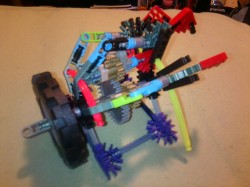
For this week, we are looking into creating actual mock prototype models of our more preferred designs. The overall purpose of these prototypes is to put our ideas from paper into hand held objects to get a better perspective of how it will operate. The photo shown to the right is an example of one of these prototypes. This model made out of K’Nex, is a representation of what a mechanical hand could be like to play the recorder.
Week 4 10/13 – 10/17:
This week our team continued brainstorming on our previous design ideas. We are in the process of looking more into the future and determining what obstacles may interfere with the overall completion of the project. Most things that were discussed this week are confidential for design competition reasons.
Week 3 10/6 – 10/10:
This week our team continued researching various topics. We started looking into codes and regulations for instrument playing as with the ergonomics that are entailed. As a team we also started looking more in depth on our individual project ideas from before. Our goal for the next couple weeks is to narrow our final design down to a few possible ideas.
Week 2 9/29 – 10/3:
After being able to meet with Nia last week we were able to collaborate and come up with some potential designs for the recorder. We decided each team member would share his or her ideas and as a team collaborate which ones we should look into more in depth. With each idea came a lot of research that involved price, material, availability, and time considerations.
Week 1 9/22 – 9/26:
For the first week our team has started researching various topics related to the project. These topics ranged from materials of recorders, types of recorders, how to play them, etc. With our research we also came up with questions for our particular client. Later in the week we were given a chance to meet with Nia, the young girl who we are designing a recorder for, as with her mother and music teacher. This meeting was very valuable as we were able to make key measurements of Nia that we will use later on in the design stage. We were also able to see her range of motion with both arms including her wiggle. Having her music teacher there was very beneficial as we were informed of the exact musical notes she will be required to play, as with her particular hand position. Photos of her were also taken for later reference which will be uploaded to this webpage within the next few weeks.

Patrick Souliere My name is Patrick Souliere and I’m from Biddeford Maine. While attending high school in Biddeford, I took courses at the Center of Technology which focused on computer and hand drafting. After graduating from high school in 2011 I started my college career majoring in Mechanical Engineering Technology (MET) here at the University of Maine. After three years of the MET program I was able to obtain an internship at IDEXX Laboratories in Westbrook Maine. This internship was not only a great opportunity for me to apply my studies but to also gain great work experience. This work experience included a wide variety of engineering applications from computer aided design to actually manufacturing product all of which will help in successfully completing this capstone project.
www.linkedin.com/pub/patrick-souliere/8a/840/a77/
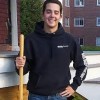
Kyle Clabby: I am a fourth year Mechanical Engineering Technology major at the University of Maine with a minor in Renewable Energy Science and Technology. I am also a proud brother of Beta Theta Pi and came to the University after graduating from Lewiston High School, Lewiston Maine. Currently, working with a team of undergraduate engineers, we are developing a device that will enable an eight year old girl, Nia, to play the recorder along with her fellow classmates. I enjoy hanging out with friends on weekends, playing intramural sports, and spending my free time fixing small engines or electrical components in R/C cars or other small electrical devices. My strengths are in understanding the mechanical and electrical components of small devices which can play a crucial role in any design and this project. After college I intend to obtain an internship at Pratt and Whitney designing jet turbines used in commercial airplanes.

Mackenzie Sutter: My name is Mackenzie Sutter. I’m a proud graduate of Wachusett Regional High School in Holden, Massachusetts, and a current 4th year student of Mechanical Engineering Technology at the University of Maine. This summer, I was able to gain a lot of engineering experience by helping with the brewing system construction and assembly at Medusa Brewing Company in Hudson, MA. There, I performed various tasks from pipe work, to metal support frame and hanger construction, to putting up stainless steel sheets on the walls. Although I am studying engineering, I am a huge fan of the creative arts; I enjoy ballet and modern dance, playing violin and viola with my band, and sewing. My sewing skills and musical background are some of my unique strengths that contribute greatly to this project. Although I mostly play stringed instruments, I also played the recorder in elementary school so my basic knowledge of the instrument and how to play it is an asset to the team. After college, I would love to work with an architectural engineering firm on HVAC design, although my dream job would be designing engineering-based toys for kids.

Alexander Doe: My name is AJ Doe and I grew up in Bowdoinham Maine. I went to school in Topsham Maine at Mt. Ararat high school and graduated in 2010. Going into college I had no idea what I wanted to do, after two years and talking to a friend multiple times about his major in MET I decided to give it a try, once I was in the major I discovered a lot of the things that I enjoyed doing in the major. This past summer I was able to acquire an internship at Midstate Berkshire in Winslow Maine. Going into the internship everything that I had learned in the MET program through the past two years quickly came back to me and I was able to apply these concepts as I worked. I worked on setup sheets for large turbine wheels and was able to use creativity when asked to design tools for the shop as well as helping draft and design things for coworkers.

Cole Predom My name is Cole Predom and I am from Ludlow, VT. I then moved and went to high school in East Providence, RI. After graduating high school in 2009 I attended Vermont Technical College and graduated in 2013 with an associate’s degree in automotive technology and mechanical engineering technology. In 2013 I transferred to University of Maine, where I am now completing my bachelor’s degree in mechanical engineering technology.
Over the past few years I have worked/interned as a machinist and manufacturing engineer at Gear Works Inc. and New Hampshire Ball Bearings. From my experience in the manufacturing industry I have learned many aspects of machining processes, computer aided design, and computer numerically controlled (CNC) programming that will be very useful to this project. After my anticipated graduation in fall 2015 I plan on pursuing manufacturing engineering.
http://www.linkedin.com/pub/cole-predom/93/a71/983/

Emily Shannon: I am a fourth year Mechanical Engineering Technology major at the University of Maine with a minor in Technical Writing. I am the proud president of Theta Tau Professional Engineering Fraternity and a graduate of Brewer High School in Brewer, ME. In my free time I like to hang out with friends, watch the Patriots or Bruins on tv, or read and write. I think my skill in technical writing and previous knowledge of music will be my best asset for this project. After college I would like to work for an architecture & engineering firm developing new systems or projects and write the technical documents for the firm.
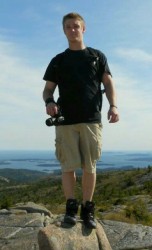
Ethan Eisenhaur: Hello I am Ethan Eisenhaur, I am currently a 5th year Mechanical Engineering Technology major at the University of Maine. Over the last two summers I was able to work at the Boston office of WSP, an international engineering firm. I mostly designed and drew HVAC equipment and systems using CAD and Revit software. There I gained much knowledge and experience of 2D and 3D CAD and HVAC engineering. I believe that this experience with 2D and 3D drawing will help me contribute to my Team and to Project as a whole. After I graduate I would like to find a job in the HVAC design field, but my dream job would be more on the machining and designing field in the automotive field.
Gantt Chart/Bill of Materials
Team Gantt Chart
Sponsors/Donations
* Shawn Eary,
P.E., Research Engineer
B.S., Mechanical Engineering Technology, University of Maine, 2009
* Glen Sargent,
Professional in Woodwind instruments
* Joe Shaw,
Bangor Brass & Woodwind Repair

